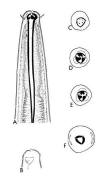 |
-
Stoma elongate, cylindrical, tubiform, cuticularized
walls, surrounded buy 3 lips at the anterior opening.
-
Six inner labial papillae surrounding stoma opening, six
outer labial papillae, 4 cephalic setae
-
Stoma armed either anteriorly with three large movable
claw-like teeth.
-
Amphid apertures stirrup-shaped
-
Esophagus cylindrical
widening near base, esophageal glands open anteriorly near
the stoma.
-
Body cavity often packed with
crystalloid particles.
-
Tail tapering to an elongate point.
-
Females usually with two ovaries.
-
Males when present have paired
spicules and a small
gubernaculum.
-
Male with a single supplement ellevated on a papilla or seta.
-
Caudal glands and
spinneret absent.
-
Primarily inhabit freshwater and moist soil.
-
Feed as predators.
Ref: Argo and Heryns, 1972; Shokoohi et al., 2013;
Girgan et al., 2021
|